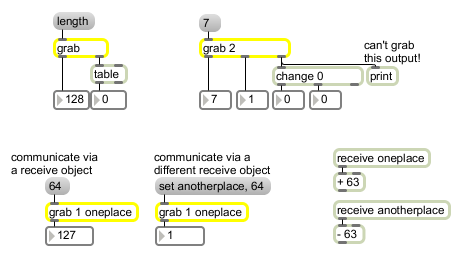Examples

Get an object's output by 'grabbing' it before it comes out the outlet... grab can communicate with any receive object specified by a set message
Intercept the output of another object
| Name | Type | Opt | Description |
|---|---|---|---|
| number-of-outlets | int | opt | The first argument sets the number of outlets, in addition to the right outlet. If there is no argument, grab has 1 additional outlet. |
| receive-name | symbol | opt | If a symbol is present as a second argument, the message received in the inlet is sent to all receive objects named by the symbol, instead of being sent out the right outlet. In this case the rightmost outlet, which would normally send out the incoming message if no second argument were present, will not exist. |
| bang | Performs the same function as . | |
| int | input [int] |
Performs the same function as . |
| float | input [float] |
Performs the same function as . |
| list | input [list] |
Performs the same function as . |
| anything | input [list] |
The message is sent out the right outlet, or if a second argument is present the message is sent to receive objects named by the second argument. |
| set | input [symbol] |
If a second argument has been typed into grab specifying the name of a receive object, then the word , followed by a symbol, specifies the name of a (different) receive object via which grab can grab messages from remote objects. |
